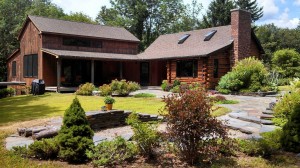Okay, spring is right around the corner and it’s time when we all start thinking of the great things we’re going to do with our yards this year.
This is a great time to think about the how’s and why’s of design before you start storming the local Home Depot and clear them out of pansies and Easter hydrangeas that will never survive the next winter. Let’s take a step back and learn a little about the design process so you can be ready to make some real progress this spring! First, take a deep breath, there’s still snow on the ground in most places and there’s plenty of time before the spring rush. So, grab a cup of coffee and settle in, we’ve got a lot say on this topic….
Good Design Starts with You
First and foremost, the design process starts with you and your family. You are the ones living in your house. This may sound obvious, but it’s something you should think about. We’ve all spent hours dreaming over Pinterest pics all winter (Yes, we’ve got a Pinterest account too.), but none of those pics on your “Dream Garden” board are of your house. None of them were created for you and your family. Even though it may be tempting, the last thing you should ever do is cut and paste someone else’s “Dream Garden” into your own back yard. Design sources like Pinterest and Houzz are great places to find ideas and tips to get you closer to your design goals, but don’t let them become your design goal!
This spring, start out on the path to really improving your living space and landscape by designing for you! This is true for both indoor and outdoor spaces. The first step is to put away all the images and photoshopped dreams you’ve accumulated over the winter and think about how you live in your space. Really think about it. What doesn’t work? What’s missing from your space that has you looking for design ideas? Do you want to entertain more? Do you need a quiet space for yourself? Do you need a better place for the kids to play in? Do you need a spot for your teenager’s entourage to hang out in? Maybe a better set up for grilling? Maybe you just need a little more green in your life? These are all the beginnings of design goals. The design process should never start by looking at a picture of someone else’s house and saying “I want my house to look like that!” Start by creating goals based on the way you live. Your primary goal should always be to improve the way your living space works. Spaces that work well have a sense of harmony that makes them desirable to everyone.
Set Your Design Goals
Once you’ve figured out what’s working and not working in your living space, then you can go ahead and set some design goals. Design goals should be straightforward and they should address problems with your existing living space. So, first identify the problem, then create a goal to solve it. This is where most of us fall apart. We don’t think we have the design talent to solve problems with our living spaces. This is a big mistake we make. Most of the design process is basic problem solving. Sure, you may need to call on some local talent to help you here and there, but you can make real progress if you just follow some basic guidelines.
Don’t worry if you can’t solve all of your living space problems on your own! It’s easy to get overwhelmed. Start with a general goal that addresses why your space isn’t working for you. Next, you can work down to specific goals like “Make outdoor grilling easier”, or “Create outdoor space for summer entertaining”. If you’re afraid you don’t have a good “eye” for design, don’t worry. Once you have a goal or a whole list of them, pick a starting point and go for it! You’ll find that making the space “look good” won’t come until the final steps of the design process. Remember that your goals can also address emotional needs, not just physical problems with your space. Feeling better about your surroundings is part of making your space work.
Start Designing
Once you have your goal set, start problem solving. Don’t start thinking about how your new space will look yet, just start by thinking about how to get to your design goal logistically. Where will things go? How will traffic flow? Here are some tips to solving your living space problems:
1) Avoid creating spaces that require a great deal of discipline to use or maintain. Your designs should accommodate the way your family lives. If your design requires your family to change its habits, it’s doomed to fail.
2) Let your design encourage new behavior on its own. You’ll find you can change habits and traffic flows naturally by creating spaces that force or encourage behaviors. Better yet, if you can design around existing behaviors, even better! Never try to change behavior or traffic patterns just to accommodate a new design. Instead, use design to change behaviors that you think need to be changed.
3) Think practically! Don’t create spaces that fulfill a romantic vision. Create spaces that you will really use. Picture yourself using your new space. When will you use it? How often? Who else will use it and how? Avoid creating spaces that are far from your normal traffic pattern.
4) Once you have your basic design ideas, then (and only then!) start to think about how they will look. This is when you pull up all those Pinterest images and start to apply styles to your basic design concept. Instead of cutting and pasting, you should now be applying styles from designs you like onto your own design. Look for styles that fit the mood you’re going for.
5) Avoid what’s “in” and “trendy”. Well-designed living spaces should be timeless. If you switched out your formica countertops for Corian in the 90’s, then upgraded to granite in the 00’s and are now thinking about pouring concrete in your kitchen, then we’re talking to you! Our rule is that what’s “in” today will be “out” tomorrow. Look for styles that fit the design and mood you want, but are not representative of the latest fads.
You’re ready to go!
Once you have your design concept and style picked out, the rest is easy. If you really feel you need help to bring it all together, this is a good time to ask for it. Even better, if you think you can do it yourself, go for it! The important thing is that you’ve thought through your design process and you have a clear idea of how you want to improve your living space. There is a natural beauty to well-designed spaces because they work! “Decorating” is just the icing on the cake of a well-designed space. Spend your time developing solid goals and basic design concepts that make your life easier and better, then you can have fun decorating and planting the spaces after. No amount of “decorating” can ever fix a poorly-designed space.
Check out our Landscape Elements section for tips on creating specific features of your landscape and our Think Like a Garden Designer for more info on learning to design.
Happy Designing!




Need a bit of help with my half shade and afternoon sun areas in my front and north side front yard. Did you grow up in Ashland, off of Cordaville Road?
Sure, I grew up on Thomas St in Ashland. Nice to hear from someone back home.
I’d be happy to help you. email me at sbreed82@yahoo.com and we can discuss details.
Steve